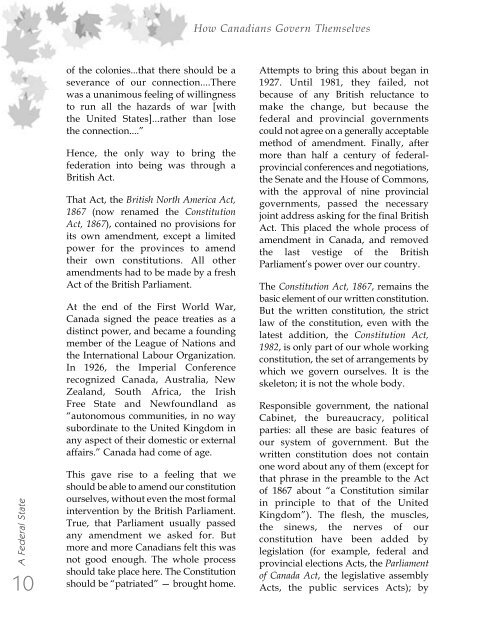How Canadians Govern Themselves - Parlement du Canada
How Canadians Govern Themselves - Parlement du Canada
How Canadians Govern Themselves - Parlement du Canada
You also want an ePaper? Increase the reach of your titles
YUMPU automatically turns print PDFs into web optimized ePapers that Google loves.
<strong>How</strong> <strong>Canadians</strong> <strong>Govern</strong> <strong>Themselves</strong>A Federal State10of the colonies...that there should be aseverance of our connection....Therewas a unanimous feeling of willingnessto run all the hazards of war [withthe United States]...rather than losethe connection....”Hence, the only way to bring thefederation into being was through aBritish Act.That Act, the British North America Act,1867 (now renamed the ConstitutionAct, 1867), contained no provisions forits own amendment, except a limitedpower for the provinces to amendtheir own constitutions. All otheramendments had to be made by a freshAct of the British Parliament.At the end of the First World War,<strong>Canada</strong> signed the peace treaties as adistinct power, and became a foundingmember of the League of Nations andthe International Labour Organization.In 1926, the Imperial Conferencerecognized <strong>Canada</strong>, Australia, NewZealand, South Africa, the IrishFree State and Newfoundland as“autonomous communities, in no waysubordinate to the United Kingdom inany aspect of their domestic or externalaffairs.” <strong>Canada</strong> had come of age.This gave rise to a feeling that weshould be able to amend our constitutionourselves, without even the most formalintervention by the British Parliament.True, that Parliament usually passedany amendment we asked for. Butmore and more <strong>Canadians</strong> felt this wasnot good enough. The whole processshould take place here. The Constitutionshould be “patriated” — brought home.Attempts to bring this about began in1927. Until 1981, they failed, notbecause of any British reluctance tomake the change, but because thefederal and provincial governmentscould not agree on a generally acceptablemethod of amendment. Finally, aftermore than half a century of federalprovincialconferences and negotiations,the Senate and the House of Commons,with the approval of nine provincialgovernments, passed the necessaryjoint address asking for the final BritishAct. This placed the whole process ofamendment in <strong>Canada</strong>, and removedthe last vestige of the BritishParliament’s power over our country.The Constitution Act, 1867, remains thebasic element of our written constitution.But the written constitution, the strictlaw of the constitution, even with thelatest addition, the Constitution Act,1982, is only part of our whole workingconstitution, the set of arrangements bywhich we govern ourselves. It is theskeleton; it is not the whole body.Responsible government, the nationalCabinet, the bureaucracy, politicalparties: all these are basic features ofour system of government. But thewritten constitution does not containone word about any of them (except forthat phrase in the preamble to the Actof 1867 about “a Constitution similarin principle to that of the UnitedKingdom”). The flesh, the muscles,the sinews, the nerves of ourconstitution have been added bylegislation (for example, federal andprovincial elections Acts, the Parliamentof <strong>Canada</strong> Act, the legislative assemblyActs, the public services Acts); by




